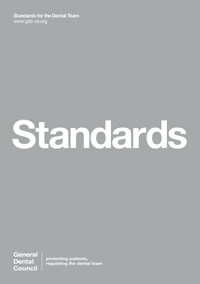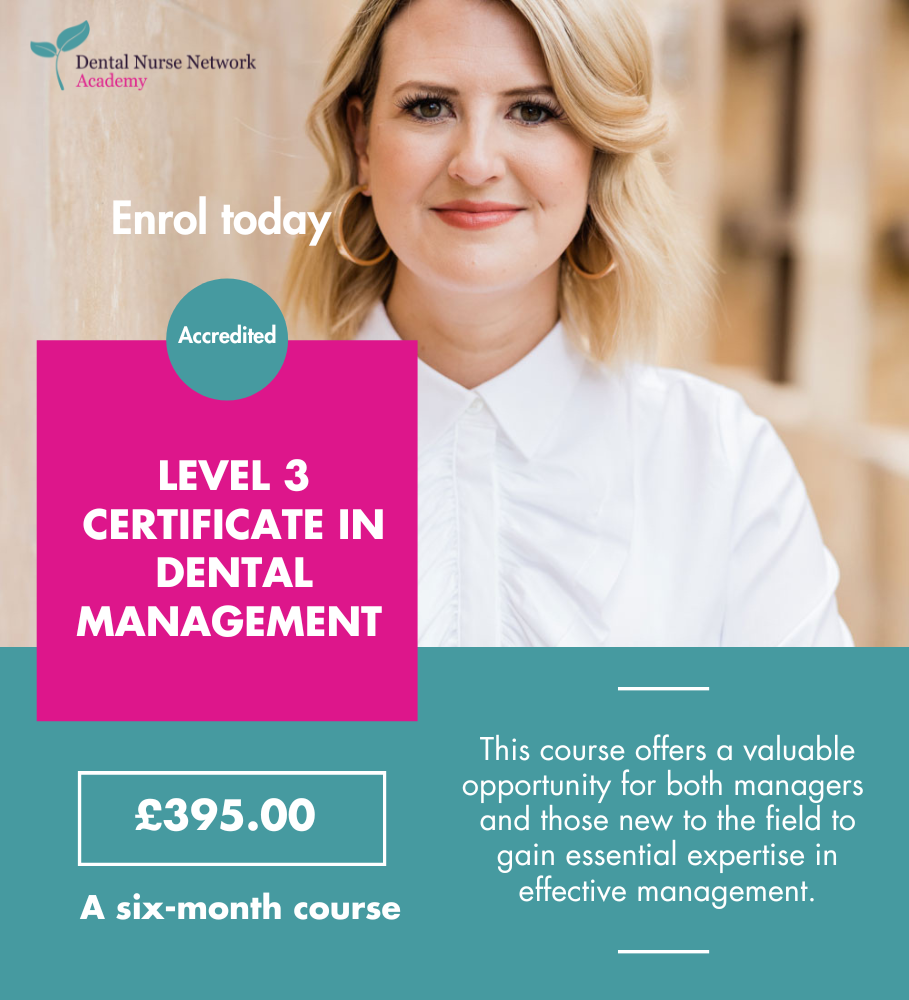 The GDC standards for the dental profession were introduced on the 30th September 2013. A set of standards and guidelines was issued to every GDC registrant.
The GDC standards for the dental profession were introduced on the 30th September 2013. A set of standards and guidelines was issued to every GDC registrant.
The standards are there to offer guidance for members of the dental profession on conduct, performance and ethics.
They also inform patients and the public about what they can expect from the members of the profession in relation to their treatment.
One of the key purposes of the standards is to provide clear outcomes against which ‘fitness to practice’ cases can be judged, and for which the profession can be held accountable.
It should be noted that although issued to the dental profession, the standards are there to protect the patient!
The standards can be accessed on the GDC website (www.gdc-uk.org) by both patients and the members of the dental profession.
Regulation
The GDC is one of 11 health and social care regulatory bodies in the UK (website details for the others can be found at the end of the article). It is responsible for:
- Registering qualifications for the dental profession;
- Setting and enforcing standards of dental practice and conduct;
- Protecting the public from illegal practice;
- Assuring the quality of dental education;
- Ensuring professionals keep their knowledge and skills up-to-date;
- Investigating and acting upon complaints received about fitness to practice;
- Helping patients and the dental profession to resolve complaints about private dentistry through the dental complaints service.
All regulatory bodies are accountable to the Professional Standards Authority (PSA), which is directly answerable to the Privy Council. Since the release of the Francis reports (www.midstaffspublicinquiry.com ), the PSA has actively enforced changes to regulation of people working with patients and vulnerable people, in order to protect them from malpractice, mistreatment and victimisation.
This has resulted in many of the regulators adopting changes to their standards, with the GDC being at the forefront of this process.
Methodology
The GDC formed a Task and Finish group from Council members comprising of dental professionals, lay members and the executive team to review, and if necessary re-structure and re-format, the existing guidance that had been in place for a number of years.
The group were tasked with establishing whether the standards:
- were fit for purpose;
- were relevant to the profession;
- were up-to-date;
- provided protection for the patient.
The group were determined that any alterations must include and be focused on patient expectations as to how dental professionals could and should meet their oral and personal needs.
Each standard is broken down into four categories:
- Principles – the core ethical principles of practice;
- Patient Expectations – what patients can expect from the dental team;
- Standards – what registrants must do to ensure patient expectations are met;
- Guidance – how registrants must meet the standards.
All categories are focused on objectives that are clear, transparent and specific. They are to help patients to understand their rights and to help dental professionals to understand their responsibilities.
 The outcome of the review was the development of nine principles:
The outcome of the review was the development of nine principles:
1. Put patients’ interests first.
2. Communicate effectively with patients.
3. Obtain valid consent.
4. Maintain and protect patients’ information.
5. Have a clear and effective complaints procedure.
6. Work with colleagues in a way that is in patients’ best interests.
7. Maintain, develop and work within your professional knowledge and skills.
8. Raise concerns if patients are at risk.
9. Make sure your personal behaviour maintains patients’ confidence in you and the dental profession.
These principles are fundamental to your day-to-day working practices within a dental environment. The guidance emphasises must and should to help differentiate between what is compulsory and what you are expected to do to the best of your ability given the circumstances.
Due to the complexity of certain subjects it was felt that additional guidance giving more detailed information on the following topics would clarify areas liable to misconception and misinterpretation:
- Advertising;
- Prescribing medicines;
- Indemnity;
- Social Media;
- Commissioning and manufacturing of dental appliances;
- Child protection and vulnerable adults;
- Reporting criminal proceedings;
- Scope of practice.
Information on all of the above can be downloaded from the GDC website, along with a presentation, including case studies, on the GDC’s standards for the dental team. The standards can also be downloaded in a poster format which is to be displayed in the waiting area for patients to access. This shows good practice in the working environment (www.gdc.org.uk).
Training
It would be very easy to glance through the Standards, feel that you are working within their boundaries, and then leave them on a shelf and not look at them again. But that would not be acting in a very professional manner, nor providing good practice to your patients and peers.
A useful way to become familiar with the standards, and also to obtain relevant Continuing Professional Development (CPD), is to hold training sessions within your working environment. These can be both informative and can provide a good team-building exercise.
Below, you will find a range of scenarios which could be used or adapted to test and improve your knowledge base. For each scenario you need to ask these specific questions:
- Which standard does this area relate to?
- What do the guidance notes specify about the related problems?
- How should the issue/problem be dealt with?
- Who should be involved in helping resolve the problem/situation?
- What could/would happen if it is not resolved?
Scenarios
1. A member of staff frequently returns from their lunch break smelling of alcohol. Although their work is not affected, they can sometimes be quite offhand with other members of staff.
2. A patient has issued a complaint regarding their treatment. They requested that a cavity be filled with a white filling material, but the dentist has inserted an amalgam filling.
3. A qualified dental nurse at a partner practice has informed you that she is carrying out teeth-bleaching for some private patients.
4. A new dental nurse who has just been employed by your practice has confided in you that although she has been qualified for three years, she has not carried out any continuing professional development.
5. Following a tiring day at work, you get home and find that a colleague has posted a comment on Twitter which states that you have been rude to a patient that day, and that you have not cleared the surgery adequately at the end of the session.
Workshop Template (example)
Name........................................... Role.................................................
A member of staff frequently returns from their lunch break smelling of alcohol. Although their work is not affected, they can sometimes be quite offhand with other members of staff.
Which standard does this area relate to?
What do the guidance notes specify about the related problems?
How should the issue/problem be dealt with?
Who should be involved in helping resolve the problem/situation?
What could/would happen if it is not resolved?
Date:....................................................
Conclusion
If you have found these scenarios helpful, why not try and develop some of your own that relate to treatments carried out in your working environment and to different members of staff. If you add aims and objectives, and devise a small feedback form for your colleagues to complete, both they and you can claim verifiable CPD.
An example is:
Aim
To update members of staff on the new GDC standards and enable them to familiarise themselves with the standards, in order to ensure that everyone understands and implements good practice.
Objectives
1. To set a series of scenarios for staff to work with.
2. To discuss and interpret areas of concern or misunderstanding.
3. To reinforce the importance of patient protection.
Feedback
Did you find the scenario relevant to your working environment?
Do you feel that you are now more familiar with the standards?
Has this helped you think more about the patient journey?
Will this session change any of your working practices?
If yes, please give an example:
Remember that training should be fun as well as educational, so be open with discussion, talk about the different roles and expectations, and enjoy the learning!
The other health and social care regulatory bodies are:
General Medical Council (GMC) – www.gmc-uk.org
Nursing and Midwifery Council (NMC) – www.nmc-uk.org
Health and Care Professionals Council (HCPC) – www.hcpc-uk.org
General Optical Council (GOC) – www.optical.org
General Pharmaceutical Council (GPhC) – www.pharmacyregulation.org
General Osteopathic Council (GOsC) – www.osteopathy.org.uk
Including:
Care Council Wales (CCW) – www.ccwales.org.uk
Northern Ireland Social Care Council (NISCC) – www.niscc.info
Author: Janet Goodwin BA(Hons), RDN, LCGI


